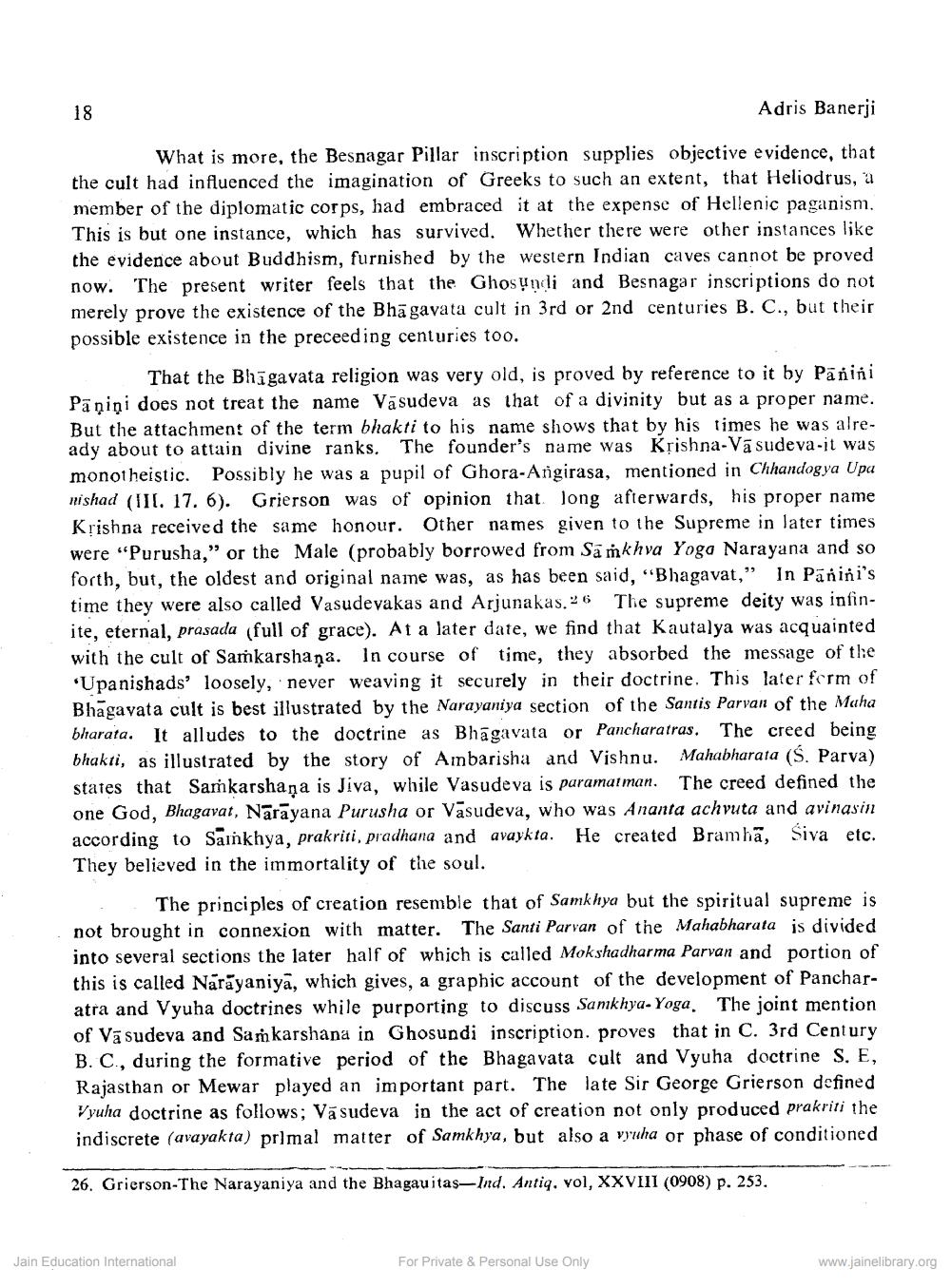Book Title: Religious Conditon in SE Rajasthan from early Inscriptions Author(s): Adris Banerji Publisher: Z_Jinvijay_Muni_Abhinandan_Granth_012033.pdf View full book textPage 8
________________ Adris Banerji What is more, the Besnagar Pillar inscription supplies objective evidence, that the cult had influenced the imagination of Greeks to such an extent, that Heliodrus, a member of the diplomatic corps, had embraced it at the expense of Hellenic paganism. This is but one instance, which has survived. Whether there were other instances like the evidence about Buddhism, furnished by the western Indian caves cannot be proved now. The present writer feels that the Ghosni and Besnagar inscriptions do not merely prove the existence of the Bhagavata cult in 3rd or 2nd centuries B. C., but their possible existence in the preceeding centuries too. 18 That the Bhagavata religion was very old, is proved by reference to it by Panini Panini does not treat the name Vasudeva as that of a divinity but as a proper name. But the attachment of the term bhakti to his name shows that by his times he was already about to attain divine ranks. The founder's name was Krishna-Vasudeva-it was monotheistic. Possibly he was a pupil of Ghora-Angirasa, mentioned in Chhandogya Upa wishad (111. 17. 6). Grierson was of opinion that long afterwards, his proper name Krishna received the same honour. Other names given to the Supreme in later times were "Purusha," or the Male (probably borrowed from Samkhva Yoga Narayana and so forth, but, the oldest and original name was, as has been said, "Bhagavat," In Panini's time they were also called Vasudevakas and Arjunakas. The supreme deity was infinite, eternal, prasada (full of grace). At a later date, we find that Kautalya was acquainted with the cult of Samkarshana. In course of time, they absorbed the message of the Upanishads loosely, never weaving it securely in their doctrine. This later form of Bhagavata cult is best illustrated by the Narayaniya section of the Santis Parvan of the Maha bharata. It alludes to the doctrine as Bhagavata or Pancharatras. The creed being bhakti, as illustrated by the story of Ambarisha and Vishnu. Mahabharata (S. Parva) states that Samkarshana is Jiva, while Vasudeva is paramatman. The creed defined the one God, Bhagavat, Narayana Purusha or Vasudeva, who was Ananta achvuta and avinasin Śiva etc. according to Sainkhya, prakriti, pradhana and avaykta. He created Bramha, They believed in the immortality of the soul. The principles of creation resemble that of Samkhya but the spiritual supreme is not brought in connexion with matter. The Santi Parvan of the Mahabharata is divided into several sections the later half of which is called Mokshadharma Parvan and portion of this is called Narayaniya, which gives, a graphic account of the development of Panchar atra and Vyuha doctrines while purporting to discuss Samkhya-Yoga, The joint mention. of Vasudeva and Samkarshana in Ghosundi inscription. proves that in C. 3rd Century B. C, during the formative period of the Bhagavata cult and Vyuha doctrine S. E.. Rajasthan or Mewar played an important part. The late Sir George Grierson defined Vyuha doctrine as follows; Vasudeva in the act of creation not only produced prakriti the indiscrete (avayakta) primal matter of Samkhya, but also a vyha or phase of conditioned 26. Grierson-The Narayaniya and the Bhagauitas-Ind. Antiq. vol, XXVIII (0908) p. 253. Jain Education International For Private & Personal Use Only www.jainelibrary.orgPage Navigation
1 ... 6 7 8 9
